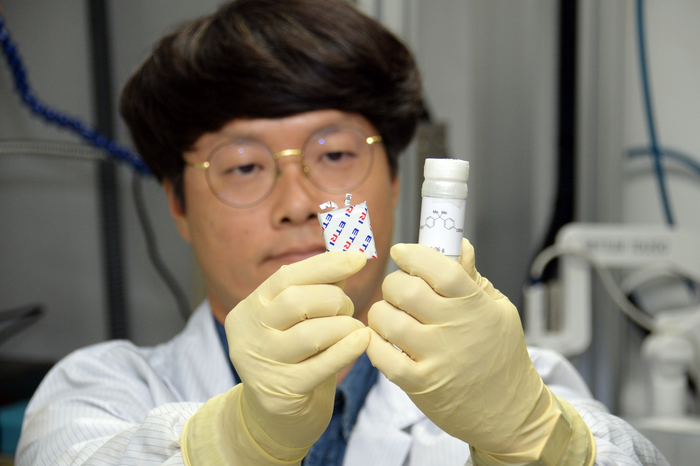ETRI announced the development of a fluorosulfate-based flame retardant additive with greatly improved flame retardant properties, electrochemical stability, and cell performance when compared to triphenyl phosphate (TPP), a phosphorous flame retardant commonly known as a traditional flame retardant (not yet commercialized). The development is believed to be extremely beneficial in attaining high-safety lithium-ion batteries and overcoming the fire risk associated with electric vehicles.
 ETRI researcher is observing a fluorosulfate-based flame retardant additive (right) and a lithium-ion batteries to which the additive is applied (left). Image Credit: Electronics and Telecommunications Research Institute (ETRI).
ETRI researcher is observing a fluorosulfate-based flame retardant additive (right) and a lithium-ion batteries to which the additive is applied (left). Image Credit: Electronics and Telecommunications Research Institute (ETRI).
A lithium-ion battery is composed of four parts: a cathode, an anode, an electrolyte, and a separator. Lithium ions flow from the cathode to the anode to be charged with input energy, then back to the cathode to release energy.
The electrolyte is a material that allows the lithium ions in the battery to move freely. In contrast, the separator allows only the lithium ions to pass through while preventing contact between the cathode and anode. This is due to the possibility of a fire resulting from a powerful chemical reaction when the cathode and anode come into direct contact.
An electrolyte additive is a substance added to electrolytes in a modest proportion. It is a critical component that enhances the electrochemical stability and performance of secondary batteries. Existing conventional phosphorous flame retardant additives possessed flame retardant capabilities, but a significant amount was required.
Furthermore, between the electrode and the electrolyte, interfacial resistance occurred. Interfacial resistance is a chemical reaction that occurs at the interface where two materials with different characteristics come into contact. When this resistance increases, issues like battery performance degradation and lifespan reduction arise due to decreased ionic conductivity. A broader range of additive applications had several practical limits.
As a result, the ETRI researchers conducted electrochemical experiments on more than ten different types of commercially available phosphorous flame retardants, produced a fluorosulfate-based flame retardant additive for the first time, and enhanced the shortcomings of conventional phosphorous flame retardants.
The discovered flame retardant additive was used in a cell with a lithium nickel, manganese, and cobalt transition metal oxide cathode (Nickel content >90%) and a lithium metal anode. These tests validated the performance of fluorosulfate-based additives by boosting battery performance while also improving flame retardant properties.
As a result, the flame retardant qualities were enhanced 2.3 times and the battery performance by 160 % to the electrolyte to which the typical flame retardant addition was added. According to the research team, when the fluorosulfate-based flame retardant was administered, the interfacial reaction between the electrode and the electrolyte was limited, resulting in a considerable drop in interfacial resistance.
Furthermore, this fluorosulfate-based flame retardant additive has the advantage of being simple to commercialize because it can be employed with a minimal quantity of additive generated without requiring an extra process change in the existing lithium-ion battery manufacturing process.
Through numerous electrochemical experiments, the research team found the properties of fluorosulfate-based additives and verified why certain operation mechanisms are achievable.
This accomplishment was published in the most recent issue of the Royal Society of Chemistry’s Journal of Materials Chemistry A, a world-class academic journal in materials and chemistry.
We wanted to overcome the limitations of exiting flame retardant additives and realize highly safe lithium-ion batteries through these research on new type of flame retardant additive. In the future, we will make efforts to contribute to the commercialization of fluorosulfate-based flame retardant additive to the practical electric vehicle cells.
Jimin Oh, Senior Researcher, Intelligent Sensor Lab
The ETRI investigators have devised a strategy for conducting additional investigations on the use of a flame-retardant additive material in lithium metal oxide anodes and lithium metal cathodes in black oxide electrodes and silicon electrode cathodes.
The research was funded by the “Development of High-Performance Multi-functional Electrolyte and Additive Characteristics Improvement Technology for Lithium-ion Batteries” project of the Ministry of Science and ICT and the National Core Material Research Center of the Korea Research Foundation.